By Christopher Miskimon
By mid-January 1945, the famous Battle of the Bulge, a massive and fatal failure for the Third Reich, was virtually over. Some 100 miles to the south, another German offensive was likewise failing, this one smaller, less well known, but just as furious and bloody.
Operation Nordwind began on the last day of 1944; elements of two German army groups attacked the U.S. Seventh and French First Armies in the snowy Vosges Mountains of northeastern France near the German border. Like the battle in the Ardennes, the Americans were initially pushed back, but their opponents could not sustain their effort, leading to defeat by the end of the month.
Within the wider story of that ill-fated offensive, there were many smaller stories of desperate combat; Nordwind had its own versions of St. Vith and Bastogne. One such involved the encirclement and destruction of an American infantry battalion during five days of combat so intense that even veterans of Anzio were shocked by its ferocity.
The fight took place in icy, hilly terrain near a small French town, and the battle, known only to a relative few, has since been known as the Battle of Reipertswiller. Taken in the larger context of the war, this was a small engagement easily overshadowed by events in the Ardennes. Yet, those who were there remember it vividly as a desperate struggle to stave off a German attack and rescue beleaguered comrades.
The 157th “Thunderbirds”
For many of the American soldiers in the Vosges Mountains that winter, January 1945 was their fifth month in combat since Operation Dragoon, the landings in southern France the previous August. The assault had started relatively easily, giving rise to the nickname “Champagne Campaign,” as Allied troops quickly put the Germans to flight.
As the northward advance ground on, however, enemy resistance grew gradually heavier. Arrival in the harsh terrain of the Vosges, coupled with the onset of a fierce winter, ended any thought of a lightning thrust into southern Germany. In the simple words of American battalion commander Felix Sparks, “The war slowed down.”
Sparks’s unit would be the main American combatant in the coming fight at Reipertswiller. His 3rd Battalion, 157th Infantry Regiment, 45th Infantry Division, known as the “Thunderbirds,” had been fighting since coming ashore at Sicily in July 1943. After a month of hard fighting across Sicily, followed by the amphibious landings at Salerno and then at Anzio where the division prevented German efforts to split the Allied beachhead, the Thunderbirds were nearly worn out.
Originally a Colorado National Guard outfit, this long period of combat had changed the 157th. Casualties and attrition had drained the original membership away, so many soldiers were replacements from across the nation. Only a few men remained from the regiment’s muster in 1940. Sparks was one of those few.
Arriving as a new lieutenant during training at Fort Sill, Oklahoma, he had spent the entire war with the 157th except for a short time while wounded. That time was cut short when he went AWOL from the hospital to get back to his soldiers. By January 1945, he was a 27-year-old lieutenant colonel, having risen on merit to command the regiment’s 3rd Battalion.
That regiment was more or less typical of many late-war American fighting formations. There were indeed many replacements, not all of them trained as infantrymen. The core of the 157th, including much of its leadership, were those who managed to survive Sicily, Salerno, and Anzio before invading France. It was an experienced regiment in an experienced division and formed the core of a regimental combat team (RCT), a combined-arms unit with the infantry as its essential center with artillery, armor, and engineers supporting them, attached to the team as the need arose.
The 157th was typically given the 158th Field Artillery Battalion, an Oklahoma National Guard unit, as its direct support artillery. Equipped with 105mm howitzers, the 158th was a skilled unit able to respond quickly to calls for fire. In addition, the RCT normally had a company of tanks from the 191st Tank Battalion, as well as engineer, tank destroyer, and medical assets at hand. This made for a flexible and powerful organization.
Still, the 157th had the same problems as other RCTs in the winter of 1945. It was understrength; the replacement pipeline had not kept up with the needs of an army in difficult, grinding action. This was most apparent in the infantry; all the 157th’s rifle companies were at two-thirds strength at most. The soldiers who were present were often exhausted and in need of rest periods that were, by necessity, infrequent and short. Winter clothing was hard to obtain, siphoned off by rear-echelon troops before it could reach the front lines. Fortunately, German units were usually in no better condition.
The 6th SS Mountain Division: Germany’s Best Infantry Unit in the Vosges
The unit that the 157th would face at Reipertswiller had likewise traveled a long way to arrive in the Vosges Mountains in January. The 6th SS Gebirgs (Mountain) Division had formed in 1940 to guard the border between newly conquered Norway and the Soviet Union. Later it was redesignated the 6th SS Mountain Division “Nord,” or North.
Until late 1944, the division spent the war in Finland and northern Russia alongside Germany’s Finnish allies, in many ways isolated from what was happening elsewhere. When the Finns dropped out of the war in September 1944, the division was ordered to withdraw through Norway. A retreat lasting until November began, with Soviet troops chasing the Germans and urging the Finns to engage their former allies before they escaped the country.
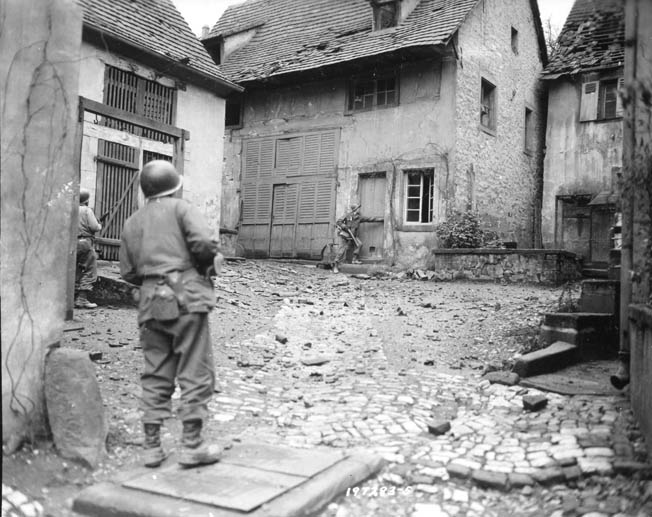
The Finnish pursuit was halfhearted, and the 6th SS succeeded in reaching Norway, where it boarded trains for home. Along the way Norwegian resistance fighters considered attacking the train, including a Hollywood-style scheme to blow a bridge, sending the train hurtling to its doom. In the end the resistance decided not to attack, fearing reprisals against civilians. This decision likely saved many Norwegians but left the division on its journey to a fateful clash with the 157th.
After refitting in Denmark, the unit was earmarked for the Ardennes but was instead sent farther south for Operation Nordwind where it engaged the Americans in the Vosges. Like the American units, the 6th SS had problems with the quality of its replacements and little time to properly rest and reconstitute. It also had a hard core of experienced soldiers and leaders well versed at fighting in mountainous, forested terrain like that found around Reipertswiller.
Equipment and fuel shortages were endemic to German units at this point in the war, but high esprit de corps and commitment made units like the 6th SS a force to be reckoned with. One historian called the unit the best German infantry formation in the Vosges in early 1945, perhaps the best on the Western Front.
Operation Nordwind Begins
In the predawn hours of January 3, 1945, Operation Nordwind slammed into the American lines like a sledgehammer; German artillery punished unsuspecting GIs as infantry relentlessly attacked them. The 45th Division was bolstered with four attached infantry regiments to withstand the assault. Artillery and armored assets were also given to the division. The hard-hitting Germans managed to inflict heavy casualties and take many prisoners during the first week of fighting. The 12th SS Mountain Regiment, part of the Nord Division, extended too far and became encircled by American troops from several regiments. However, many SS soldiers were able to slip through the surrounding Yanks during the night of January 6-7 and regain their own lines.
On January 11, the German troops renewed their offensive, hitting the Americans in several forested areas north of the border village of Reipertswiller. Artillery fire was heavy, and soon two battalions of the 45th’s 180th Infantry had to fall back some 600 yards. In turn, this exposed the flank of another battalion of the attached 314th Infantry, 79th Division, forcing them back as well.
This move left two hills, 343 and 388, in the hands of the enemy. The 2nd Battalion, 157th, was sent to retake the hills that night. They were successful and spent January 12 defending the two hills from attacks by SS men supported by artillery. Relieved that night, battalion commander Lt. Col. Lawrence Brown moved his men to Reipertswiller, where they collapsed into any space they could to sleep. Before long, however, they were back on the front lines.
On January 14, the Americans were ready to start pushing back against the German onslaught. The 45th Division commander, Maj. Gen. Robert T. Frederick, ordered an attack to retake the hills north of Reipertswiller. Two battalions of the 157th––Sparks’s 3/157 and Lt. Col. Ralph Krieger’s 1/157––were sent to carry out this mission that morning. Other units along the front would attack as well. Sparks’s battalion was the left flank unit of the division, with Krieger’s men to its right and a battalion of the 79th Division’s 315th Infantry to its left. Most of the units were understrength; 3/157 was short about 200 soldiers in its rifle companies.
As the riflemen prepared, a platoon of 4.2-inch chemical mortars capable of firing smoke or explosive rounds set up in Reipertswiller. Machine-gun sections from the weapons companies were attached to each rifle company for added firepower. A platoon of tanks was available but held back to be used where needed; minesweeping engineers would accompany the infantry. For 3/157, Company K would advance on the left and Company L on the right with Company I in reserve. For 1/157, Companies B and C would advance with A in reserve.
Driving Into a Mine Field
Shortly before the attack, Lt. Col. Sparks climbed into his jeep to join his battalion; the young commander was known as an officer who stayed up front with his troops. With him were his driver, Albert Turk, a runner named Carleton Johnson, and a translator, German-born 19-year-old Karl Mann, who had been in a machine-gun crew until being tapped to use his fluency in German.
Mann found Sparks a curious figure. The officer was not one for casual conversation and often carried a shotgun pitched over his shoulder. Mann didn’t know it, but Sparks had grown up hunting in Arizona to help feed his family during the Depression. He felt more comfortable with a shotgun than a carbine or rifle; he didn’t feel he could shoot either as well. His .45 pistol had custom grips containing photos of either his wife Mary or a pinup girl, depending on which version of the story one believes.
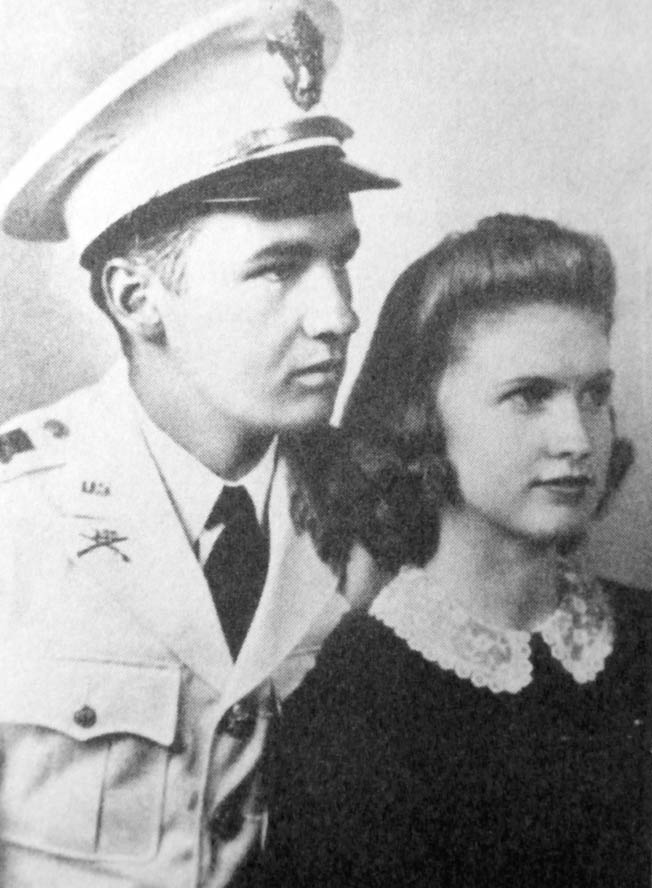
Turk was driving the jeep down a paved road covered in a few inches of fresh snow from the night before. Mann was in the back sitting on a sleeping bag while Sparks was in the front passenger seat. Without warning an explosion tossed the jeep violently; they had struck a mine. The young interpreter was lucky. The sleeping bag absorbed much of the blast and, though in shock, he was uninjured. Sparks was thrown several yards away, flying through the air to land on pristine white snow nearby. Fresh bruises covered his body, and he was cut on his left knee and right hand. Shock overcame him.
Mann climbed out of the jeep and found a horrifying sight. The jeep’s rear tire was sitting on another mine only an inch from the trigger. If that weren’t enough, a W-shaped pattern of several dozen mines lay across the road, hidden by the snow but now visible upon closer inspection. Although shaken, Turk and Johnson were miraculously unharmed.
Sparks was immediately taken to the nearby battalion aid station. With their commander out of the fight, the executive officer, Captain John L. McGinnis, took over and got the battalion moving on schedule.
“It Was the Worst Beating We Ever Took”
The American attack jumped off at 8:30 am but immediately bogged down in the face of intense artillery fire. Shell bursts churned up the snow, mixing it with soil into a dirty brown color. All too often, the snow was stained red from the blood of wounded and dead Americans.
GIs began to filter back to the aid station; Sparks was already there, having his wounds tended and recovering from the shock of the mine blast. As he lay there, Captain McGinnis was brought in, wounded by the heavy shellfire. Dismissing his injuries as minor, Sparks felt he had to return to his duties; he had to be with his men. He quickly returned to the front lines despite the harrowing artillery. He would later write, “It was the worst beating we ever took from terrific concentrated artillery barrages, and that includes Anzio. Men were unable to get out of their holes, even without enemy infantry in front of them.”
Beyond sporadic machine-gun fire, the GIs had almost no contact with enemy infantry. Whenever they pushed forward, it seemed only more artillery and mortar fire greeted them. Despite the murderous rain of steel, the Americans kept moving; by 4 pm Sparks’s riflemen had managed to advance about 1,200 yards.
Winter’s early darkness descended over the thick woods, so Sparks ordered all three companies to dig in for the night. The day’s results had been disappointing but understandable given the intense barrage, but none of the other attacking battalions had done any better. In fact, 3/157 had advanced farther than any of them.
Shortly after 6 pm a message came in from regimental headquarters warning of a German counterattack brewing in front of them. An estimated five German battalions would be committed in the 45th Division sector. The attack order stood; however, the regiment would resume moving forward in the morning.
While the German shelling continued through the night, Sparks planned for the coming day. Companies K and L were each assigned a hill to seize with Company I in reserve, filling the gap between the two lead companies.
Heavy Casualties on Both Sides
The attack resumed at 9 am on the 15th. Enemy artillery fire was still heavy but the GIs kept moving. This time they ran into a company from the German 476th Infantry Regiment, 256th Division, and routed it, sending six prisoners back to the POW pens in the rear.
The advance continued until 12:30 pm. By then both lead companies had reached their assigned hills. Company K occupied Hill 420 while Company L took Hill 410, both designated by their height in meters. Company I moved into the saddle between the two hills to form a continuous front 800 yards long.
The hills had commanding views and represented a solid position, but unfortunately the units on either flank of 3/157 had been unable to achieve their objectives and were far behind, leaving Sparks’s battalion dangerously exposed. Krieger’s 1/157 tried to advance to close the gap on 3/157’s right flank, and Company B managed to capture a ridgeline but was quickly pushed back. Afterward, Company C sent patrols to link up with Company L along the same route 3rd Battalion had used to get to its objectives.
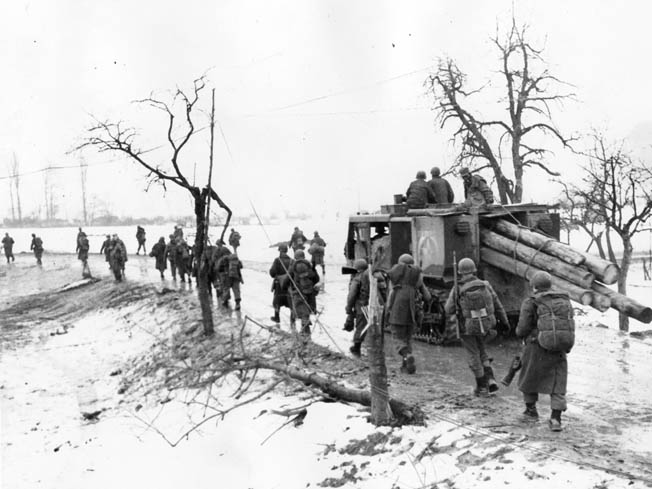
At 4:15 pm, a company of German troops counterattacked Company K, hitting hard on its left flank. Sparks sent the battalion’s antitank platoon to shore up the beleaguered riflemen. Fighting raged for over an hour before the Germans were repulsed; 50 bodies littered the ground in front of Company K. About half of them lay together in a group, killed by machine-gun fire.
American casualties were heavy as well. A sergeant from Company K recalled, “It was the worst mess I ever saw. Dead and wounded Americans were lying all over the area. We had no way of evacuating the wounded, much less the dead, until night.” GIs searched the enemy corpses and found papers showing them to be from the 12th Company, 11th Regiment, Nord Division.
Even after the attack stopped, mortar fire kept raining down as Sparks’s men struggled to bring up ammunition. Friendly casualties were evacuated along with 16 prisoners, including the six taken earlier. Those half dozen were from the German 476th Infantry Regiment, 256th Division. Interrogations revealed that the unit had just relieved the 6th SS that morning. One soldier overheard an officer talking about holding a nearby American-occupied position at all costs. Another heard that the SS unit was receiving replacements so it could resume the offensive.
118 Soldiers Lost in the 3rd Battalion
As the night continued, Sparks reorganized for the next day. The antitank platoon was recalled to form the battalion reserve. Headquarters company used every available man to move ammunition and food to the rifle companies. With those units in such exposed positions it was harrowing work, but they kept on through the night.
The 1st Battalion, 315th Infantry was the unit immediately to Sparks’s left flank; it was ordered to cease advancing and make ready to return to the 79th Infantry Division, its parent unit. To fill the void, the 2/157 was ordered to move up on Sparks’s left while Krieger’s 1/157 continued to close up on the right.
The morning of January 16 saw the two battalions trying to do just that. By 11:45 am, Company C had managed to link up with Company L’s right flank. Just over an hour later, as Company G was attacking to reach Company K’s left flank, a general German attack began along the entire local front line.
At the same time, other German troops began infiltrating around 3/157’s flanks and behind it. Artillery roared overhead from both sides, and both found it punishing. By 3:40 pm, Company I had Germans behind it and apparently coming from the left flank. Company B was sent to clear those Germans out but was unable to do so. Sparks sent his reserves, the antitank and engineer platoons, to open up the supply route to his rifle companies. Two light tanks, M-5 Stuarts, went with them. This mission succeeded after a brief firefight and temporarily opened the road.
By 6 pm, Company G finally linked up with Company K. For Sparks, it seemed his flanks were finally secure, and he had a defensible position from which to continue the fight. It was thought a small number of Germans were still behind the battalion somewhere on the right, but Company B was assigned to finish them off in the morning; nothing further was done at the time.
Sparks did what he could to consolidate. Regiment sent him 100 men from the headquarters and antitank companies as his reserve. He positioned them on the supply route to ensure it stayed open and sent every spare soldier from his own headquarters company to carry ammunition and food to his battered riflemen. Each time they returned from delivering supplies, they carried casualties.
To this point, 3/157 had lost 118 soldiers over the past three days; a third of the battalion’s strength was dead or wounded. Those who remained prepared for the next day.
“A Fierce, Uphill Fight”
While the Americans were consolidating and reorganizing, the men of the 11th Regiment, Nord Division were advancing. It was poor weather for a fight; snow was falling, wrapping the forest in its wintry embrace, muffling noise, and making it difficult to see. Temperatures were below freezing and showed every sign of staying there.
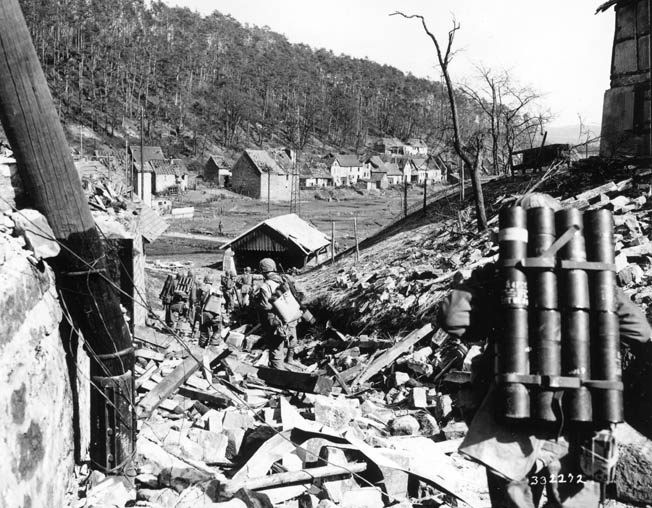
Johann Voss, a machine gunner who had been with the SS since Finland, remembered much the same things as his American counterparts, perhaps in reverse. He recalled the punishing American artillery, which never seemed to cease. For the Germans it was “a fierce, uphill fight.” American mortars and machine guns swept them as they struggled to advance on January 16, and it didn’t seem much progress was being made.
After dark, Voss and his machine-gun crew were reassigned to a different company and again sent up the hill. This time he noticed they were moving diagonally from their previous line of attack. Fighting still raged, but this company skirted around it to infiltrate around the American flanks and into their rear. Voss couldn’t tell who had the upper hand in the deafening battle on the hilltop above, but he did know the enemy was determined. Slowly, he and his comrades crept on through the dark, seeking to complete their encirclement.
They had just finished moving around the American-held hill when they almost fell victim to their own artillery. With a terrifying sound, a barrage of Nebelwerfer rockets crashed down in front of them. The entire group threw themselves flat into the frigid snow as the rockets struck the earth a scant 30 meters in front of them. The explosions tore into the ground, raising great gouts of earth and snow, but no one was hit. After a few moments the SS men continued into the night.
After a while they reached their objective, a position directly behind Company I and near the trail the Americans were using to bring up supplies. Voss later wrote, “My gun’s position was on a steep forward slope, a clearing which fell down toward a trail on the bottom of a ravine leading up to a saddle between two hilltops, one of which we had passed. We emplaced our gun under a rocky outcropping and … started digging into the frozen ground.”
Visibility improved with the dawn as the snow stopped falling, leaving the morning air crisp and cold. Voss realized the trail was the enemy supply route. He scanned it with his binoculars and saw a small bridge to his left. Somewhere out there, he knew a few soldiers had been posted along the trail with Panzerfaust antitank weapons, but he couldn’t see them. Voss settled in to wait for the inevitable action to come.
Withdrawal Request Denied
The morning of January 17 brought little relief for Felix Sparks and the men of the 157th. Company G was reinforced by a platoon of men from Company E, who managed to get through to them. The rest of Company E couldn’t break through, however. Likewise, Company B tried linking up with C but had no luck.
A patrol from Company B, probing toward Company C’s position, came upon a disheartening sight: a group of three jeeps, shot up in an ambush, dead GIs all around. It was a resupply party, led by Company C’s supply sergeant the day before. The deadly ambush had killed or captured all but two of the Americans. No one was alive at the ambush site; the survivors had long since retreated. The patrol returned to Company B just in time to man foxholes against a German attack from the northeast.
For Sparks the obvious choice was to open a path to his men and pull them back. This wasn’t a vital objective and didn’t require a “last stand.” He consulted with the regimental commander, Colonel Walter O’Brien, and suggested the withdrawal. O’Brien agreed and sent word to the 45th Division requesting to do so. A reply came back denying the request. General Frederick, who once commanded the 1st Special Service Force, apparently thought a retreat would show weakness.
Sparks was furious; he thought Frederick clearly didn’t understand the situation. Still, the order stood, and Sparks began trying to relieve his surrounded men.
One Last Resupply
Fighting continued throughout the day. German troops hit the 1st and 2nd Battalions while they struggled to link up with their trapped comrades. These attacks were beaten back, but they distracted the Americans from the effort to relieve the five companies on the hills ahead. By late afternoon Company B was down to 22 effectives in its rifle platoons, and there were only two machine gunners left from the weapons company. Afterward, 24 men arrived from other companies to bolster them.
About the same time, Colonel O’Brien sent part of the reserve force composed of antitank soldiers and engineers to clear the area behind 2nd and 3rd Battalions. Supported by two light tanks, these troops moved along the trails behind the trapped companies but quickly ran into trouble. The infiltrated SS men poured fire into them; the American commander, Captain Robert W. Cannon, and one lieutenant were killed. The remaining platoon leader withdrew his men and the tanks back toward the road to Reipertswiller.
For the encircled GIs, the situation was getting desperate. Food and ammo were running out. The 3rd Battalion’s Lieutenant Willis R. Talkington volunteered to take a pair of light tanks up the trail. A trailer was hooked to each tank to carry supplies. The freezing conditions worked against them, however. After a short distance, both tanks began slipping on the icy trail.
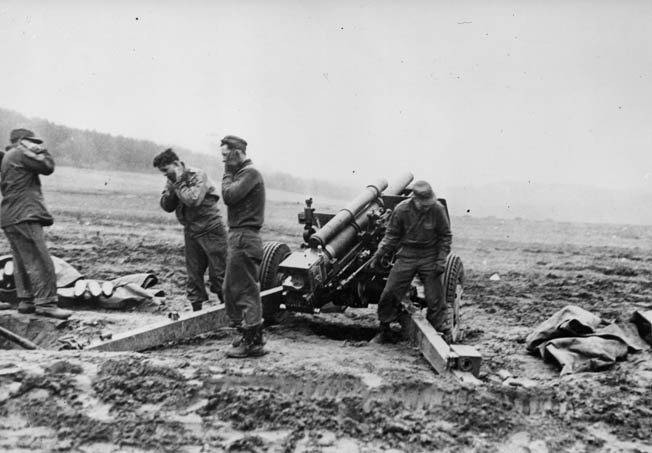
Things became worse when one tank slid into a ditch and flipped over. Talkington tried a new tactic. He loaded all the supplies onto the back deck of the remaining Stuart and abandoned the trailer. This enabled the tank to get moving again, and somehow it arrived in the Company I area without being attacked by the Germans. This was the last resupply the trapped Americans would receive.
Ambushing the Stuart
Just after midnight on January 18, the tank started back down the trail, but this time its luck ran out. A German ambush knocked it out and wounded three of the crew, who were captured. In the confusion, Talkington, also injured, managed to escape into the darkness.
From his vantage point overlooking the trail, Johann Voss saw some of the combat that raged during the day and night of the 18th. At one point he heard the rumbling of an engine; soon an American tank lumbered into view. Voss recalled the tank came from up the hill.
One of Voss’s comrades opened fire with his machine gun. As they watched, the rounds bounced from the metal behemoth’s armor and it drew closer on the trail. Suddenly a panzerfaust round came from somewhere.
“Wham! A fireball! The tank stopped cold and jerked off the road,” Voss wrote. He watched the crew scramble out of the tank only to be captured within moments by SS men. Despite his experience, it was the first time the young soldier had seen a tank destroyed. While he exulted in the small victory, he wondered what would happen when the Americans sent more tanks.
An American response didn’t take long. Rather than tanks, it was an artillery barrage an hour and a half long. Voss remembered it as the worst he ever experienced: “Shells rained upon us like hail in a thunderstorm.” He couldn’t understand how the Americans could mass such fire in one place.
The machine-gun crew doubted it would survive, but when the firing ended, the men were alive and soon saw a pair of American antitank guns setting up farther down the trail. The guns blasted away at the Germans, and before long American infantry began moving among the trees. Voss opened fire on them and eventually drove them into cover in a small hollow near the bridge. A messenger told Voss the SS troops on the hillside were mostly unharmed, but those fighting at the hilltop area had taken heavy casualties.
Down by the trail the American gunners kept firing, and more of their infantry appeared. They began pressing the Germans, and Voss feared they might break through. Suddenly, another salvo of Nebelwerfer rockets screamed in as they had the night before. The first round missed, but the next two hit the American antitank guns, destroying them.
The attack petered out soon after, GIs falling back among the same trees they used as cover while advancing. Voss could not see the American squad his fire had forced into the hollow by the bridge. He assumed they had been wounded and could not or were afraid to move. They were trapped.
A Captured SCR-300 Radio
For the Americans, January 18 started with the loss of Lieutenant Talkington’s tank just after midnight, but the situation only got worse with the dawn. On Hill 420, Company G with its platoon from Company E now occupied positions just south of Company K.
As the sun rose over the frozen landscape, German troops attacked from close range and achieved almost complete surprise. Some of the American survivors later reported the enemy using flamethrowers.
The American position was completely overrun; only 18 men made it to the Company K lines nearby. All the rest, including the entire platoon from Company E, were lost. The encircled GIs were slowly being pushed into an ever-shrinking perimeter. Ammunition and food were almost gone and there was little to be done for the wounded. Most had to remain in place and get by as best they could.
Desperately hungry, the SS men searched Company G’s lost positions for food. Picking through the scattered equipment, they happened upon a working SCR-300 radio. Their company commander, Standartenführer (Colonel) Helmut Raithel, took it back to a nearby command post. A quick search found a soldier who had lived in Chicago before the war and spoke fluent English. He set to work translating the American transmissions.
“Grazing Fire”
Across the 157th’s lines, American counterattacks went on all day in desperate attempts to reach what was left of the five trapped companies. Company E, unaware its platoon was lost, assembled clerks and cooks for an attack that failed to make headway. What was left of the antitank company had been formed into a single platoon under Lieutenant William Berg. It joined with the remnants of Company B outside the encirclement; both units had about 19 soldiers left. They were later joined by two light tanks from the 191st.
These tanks moved up the trail apparently past Johann Voss’s position without being engaged. In late morning the battalion antitank platoon moved up the same route, accompanied by three M-8 armored cars. As the Americans pressed forward they came under enemy fire; the lieutenant leading the armored cars was hit by a sniper while in his vehicle. The infantry continued forward until forced back. This is apparently the attack Voss recalled, since it was at this point several GIs were pinned down near the bridge.
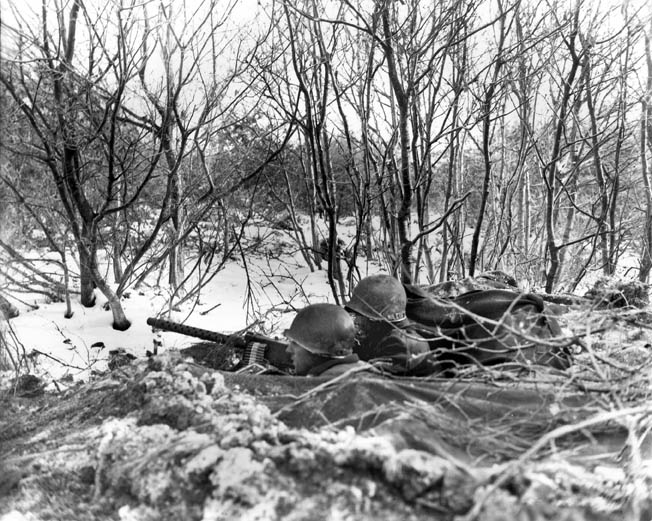
One of them was a squad leader, Sergeant Bernard Fleming. As his squad advanced through the trees machine-gun fire tore into them. Most of the fire came in low, below the level of the low-hanging branches, known as “grazing fire.” Several men were hit in the legs, likely the only part of them clearly visible to the enemy.
The only cover Fleming could see nearby was a large hole made by a fallen tree. He ordered his men into it, gaining a temporary reprieve. A few minutes later two soldiers from a different squad joined them. One of them told Fleming an order to withdraw had been given, but they couldn’t get away. When they heard Fleming’s men firing, they made their way over. Cut off, Fleming hadn’t even heard the order to fall back.
With so many wounded men, the GIs needed help to get clear. Fleming decided to send a runner to the battalion command post. Private Emmett Neff, a radioman, volunteered to go. The young soldier took off at a sprint but got only 25 yards before a burst of fire hit him in the ankles, leaving him screaming for help on the icy ground. Fleming told his men to lay down suppressing fire; every man in the hole opened up with whatever he had. The sergeant dashed to Neff and dragged him back to the hole. As he began pulling off Neff’s boots to look at his injuries, another soldier, Private Lawrence Mathiason, volunteered to go. Fleming told him to stay put. The Germans would be watching them.
Disregarding the order, Mathiason left the hole, running for the rear. After only 10 yards, he fell as bullets ripped through him. Fleming decided he had to do something personally. He took off his web gear and gave another soldier his Thompson sub-machine gun so he could run faster. “You guys stay here. I’m going to get help,” he said.
With that, Fleming ran out to Mathiason and dropped down next to him, but the young GI was dead. Rising, Fleming ran as fast as he could through a torrent of fire from the SS troops. Bullets snapped all around him; one even went through the fabric of his pants. After terrifying moments, however, Fleming managed to make good his escape and found his platoon leader. When he told the lieutenant about the trapped men, “He told me to tell Colonel Sparks, who then took a tank and went to get the wounded out.”
M-4 Shermans to the Rescue
Sparks did indeed mount a rescue effort using a pair of M-4 Sherman tanks, which had just arrived at the command post. The narrow trail was partly blocked by the overturned light tank from the night before, so a recovery vehicle was brought in to drag it out of the way.
Once the way was cleared for the M-4s, Sparks climbed aboard and led them up the trail toward his trapped and wounded men. As the tanks clattered up the trail, Colonel O’Brien called to find out what was happening. One of the battalion officers told O’Brien about Sparks leading the tanks on a rescue effort. O’Brien told the man to have Sparks stop the effort and wait for approaching reinforcements. A battalion of the 179th Infantry was coming up to help.
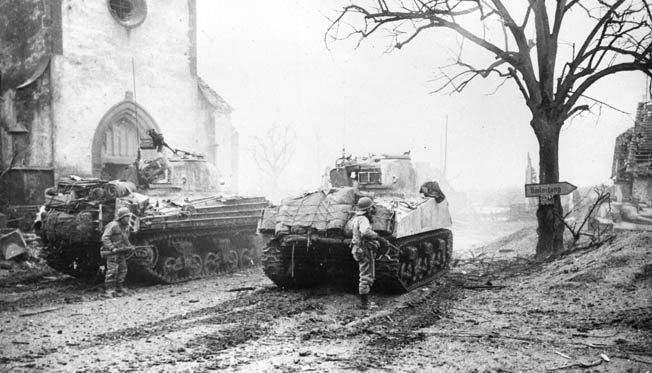
Sparks apparently got the message but chose to ignore it. Time was running out, and he was notoriously stubborn. O’Brien chose to let the matter pass and allowed Sparks to continue. Given the dire situation, O’Brien figured Sparks would ignore a direct order anyway.
Up the trail, Sparks stood in the hatch of the leading tank, urging its driver forward. Several times he halted so he could get out on foot and scout the route before remounting to continue. As the tanks neared Fleming’s men, German machine gunners began firing at the Shermans. Sparks fired back with the tank’s .30-caliber machine gun, shooting wherever he thought enemy troops might be hiding.
He also directed the gunner to open up with the tank’s long-barreled 76mm main gun. The combined effect of the tank’s firepower suppressed some of the Germans, enabling other American soldiers hiding along the trail to fall back. Sparks continued to Fleming’s men farther along the path.
Finally, the tanks approached the bridge near the trapped GIs. The trail steepened, making it hard to gain traction. Seconds later, Sparks’s tank slid sideways, leaving its right side exposed to the enemy. A panzerfaust flashed out from the trees, and a round struck the tank on the turret with a loud bang. Sparks’s luck held; he and the crew were uninjured, but the main gun was out of action. The tank was still mobile, and the machine guns worked.
“Make a Break For It!”
Standing in the hatch and looking around, Sparks saw several men in a hole near the trail, another hiding behind a tree. The man behind the tree asked, “Can I come out?”
“Make a break for it!” Sparks replied. Running for the tank, the man got only a few yards before being gunned down. Sparks snapped. He jumped down from the tank and ran over to his men. The first was about 50 yards away, shot in the chest and too heavy to carry, so Sparks dragged him back to the tank and managed to lift him onto it. The whole time, no SS men fired at him.
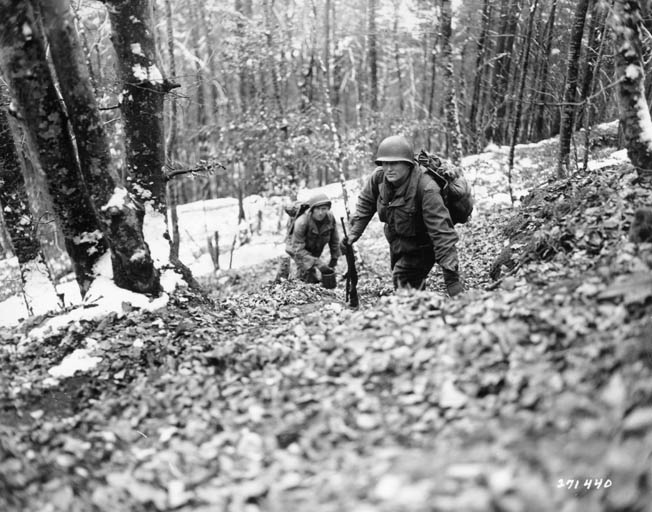
Pressing his luck, the young officer ran back and got two more men, hoisting them onto the tank’s rear deck. Only a few minutes passed, but they were long ones. At any second a burst of fire could cut Sparks down, but for some reason no one shot at him. “Inexplicably, the German troops did not fire at me during this recovery operation, although I was an easy target,” Sparks later wrote.
With the wounded loaded, Sparks ordered the tanks back down the trail, both of them banging away with their machine guns. One soldier had a broken leg, so Sparks tied a splint to it with an ammunition belt. After going a few hundred yards, Sparks again came under fire, but aside from tearing up the external stowage on the second tank no serious damage was done. Both Shermans made it back to the command post. Sparks was exhausted and wondered how he had survived.
Bernard Fleming, whose men Sparks had rescued, felt the morale of the unit soar after hearing what their leader had done. “Our commander had proved once again that he valued his soldiers’ lives and was willing to take large risks on their behalf.”
Five companies of Americans were still trapped in the hills ahead, however. Could they be rescued as well?
Why the Germans Never Fired on Sparks
Corporal Johann Voss had watched Sparks’s entire rescue from his machine-gun nest in the rocks overlooking the bridge. He saw the two tanks coming up the trail toward the bridge, the lead tank firing its machine guns. That tank suddenly spun on the ice and slid sideways; an enterprising panzerfaust gunner immediately lobbed a rocket into it. Smoke poured out and Voss watched the crew bailing out and taking cover behind the second tank. The hulk of the first tank shielded the second from the German antitank fire.
In Voss’s recollection, an American jumped from the second tank and sprinted to the hollow where his wounded fellows lay. He went back and forth, taking wounded soldiers and laying them on the deck of a tank. Voss viewed the man through his binoculars and thought he was an officer. Impressed by this selfless act of bravery by an officer for his men, neither Voss nor his fellow SS men fired at the American, who finished his task and left with the tanks the way he’d come. Voss later wrote, “There was no honor to be won by firing upon this death-defying act of comradeship.”
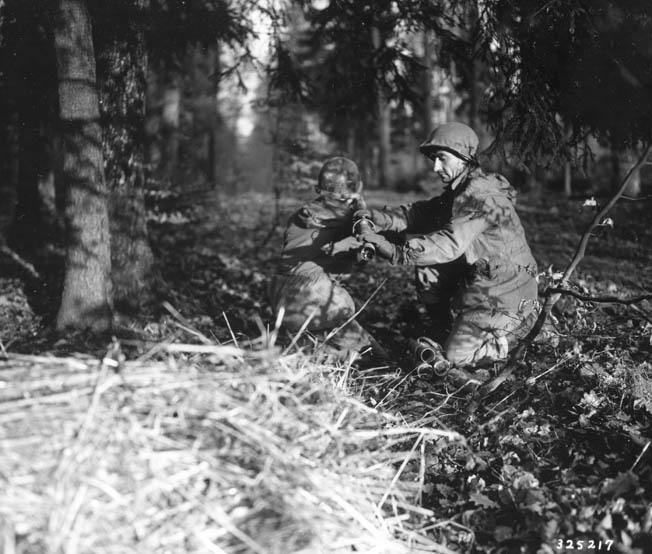
A few hours passed, and the sun began to set. The Germans had no food, and everyone was hungry. One of Voss’s men, a private named Stricker, asked to have a look at the tank they’d knocked out the day before. The corporal gave his assent, cautioning the soldier to be careful not to draw friendly fire and to be back within a half hour. Stricker carefully made his way down the slope. Before his half hour was up, he came back with captured cigarettes, cookies, and several C-rations for the men to share.
Unable to Lift the Siege
Sparks’s act of bravery was not the end of the battle. A battalion of the 179th Infantry, another regiment of the 45th Division, was committed to the fight but also unable to break the German deadlock around the surrounded 157th troops. That essentially ended the efforts for January 18. It had been a day of frustration and courage, failure and heroism for the Americans. The encircling Germans were no better off, but for the moment they had the upper hand.
A new plan was drawn for the next day. All units would hold in place except the 179th soldiers and the 1/157. They would attack in an attempt to end the siege.
January 19 began with more German shelling and small attacks by infantry designed more to keep the Americans in place than anything else. Within the perimeter the remnants of Companies C, G, I, K, and L were almost out of ammunition and had no medical supplies to treat the wounded. Some men hadn’t eaten for two days. Still, they held out, refusing to give in and praying for their fellow Thunderbirds to reach them.
The attack went off as scheduled but accomplished nothing, the only tangible result being heavy American casualties. Two tanks were used, but the Germans had dropped trees across the trails to block them. One tank slid on the ubiquitous ice and flipped over into a ditch. More tanks came up and blasted away with cannon and machine guns to no avail.
In the afternoon several men evacuated earlier for exhaustion were reorganized and placed in the line to plug gaps. Cooks and clerks from the battalion headquarters company joined with Company E to attack near Hill 420, but this action failed as well. The German grip on the area seemed unbreakable.
A Disastrous Breakout Attempt
All too aware of the plight of his soldiers, Colonel O’Brien began planning an airdrop for the next morning; it seemed the only way to get anything through. The 2nd Battalion, 411th Infantry, 103rd Division was brought in to join in the relief effort. Other rifle companies would conduct feints to distract the Germans or fire their weapons to confuse them about the main effort.
Though the batteries were slowly dying in the cold, the surrounded companies still had tenuous radio contact with their headquarters. They reported they were beating back enemy attacks but the SS were still managing to infiltrate around them. The Germans were liberally equipped with automatic weapons. Enemy artillery observers were well positioned.
The Americans knew this because each time they tried to push the enemy back concentrated rocket and artillery fire fell upon them. All the companies urged headquarters to get to them soon. Oddly, at 4:52 pm, 3rd Battalion headquarters informed all its companies, “Russians now fighting on border of Germany.”
The next morning, January 20, was cold, and before long, heavy snow began falling. The 411th Infantry’s attack went in as planned but, like those before, achieved nothing. The SS troops were suffering too, but they were skilled and determined to maintain their grip on the five trapped companies. The airdrops were attempted in the morning, but with the heavy blizzard, no supplies reached the Americans.
Just after midday the SS sent a group to the surrounded GIs under a flag of truce. The senior remaining American officer, Captain Byrd Curtis of Company K, met them. The Germans showed Curtis their positions on a map to prove they were indeed surrounded. The SS officers also promised not to mistreat any prisoners. The Americans were given until 5 pm to surrender or they would be smashed.
The surviving 157th men took a vote. All 100, all that were left, voted to continue the fight. At about the same time, the regiment was ordered to prepare to fall back as part of a larger movement by the U.S. Seventh Army. Colonel O’Brien did not want to leave his trapped soldiers, so he ordered them to conduct a breakout while the other companies fired their weapons to distract the enemy. The breakout would begin at 3:30 pm.
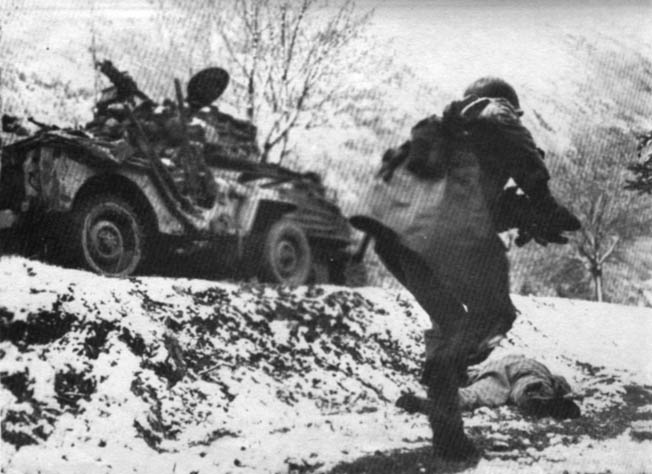
When the time came, the remaining troops from the five companies dragged themselves out of the holes they had occupied for five days and began moving to their rear. Before long artillery started falling, sending lethal shards of shrapnel ripping through the freezing air. One officer was hit directly and just disappeared. Most of the men were already wounded, some more than once. The breakout attempt was stopped cold. Before long German infantry were taking the exhausted GIs prisoner in large numbers.
Only two soldiers made it back to the 157th’s lines: Pfc. Benjamin Melton and Private Walter Bruce, both from Company I. Melton reported they set out with another man who was soon killed by machine-gun fire. The two stayed off the trails, cutting through the woods to avoid the enemy.
They saw some prints left by American shoe-pacs (winter footwear) and followed them until they saw a shelter half that appeared to cover a foxhole. Hiding, they watched it until an American soldier poked his head out from beneath it. “You can imagine how glad we were to see that guy,” Melton said.
A Bitter Argument Between Sparks and Frederick
Since viewing Sparks’s rescue, Corporal Voss had experienced cold, hunger, and long hours without sleep. Hiding in his foxhole from relentless artillery strikes, he dozed and dreamed of becoming a farmer after the war. Then he found out the trapped Americans had surrendered. It was over.
The next day, he and his comrades were pulled off the hill. They passed through part of the battle area and saw frozen bodies still on the ground. Voss had to be treated for frostbite to his toes.
For the captured Americans, their initial experience was surreal. SS units were infamous for brutal treatment or execution of prisoners. The massacre of GIs at Malmedy was a recent event. The captured survivors of the 157th were taken behind German lines to the SS unit’s mess line and allowed to go through it. Johann Voss heard each American was given a box of German chocolate as well, leaving the SS soldiers without any.
The Germans were so impressed by the courageous resistance their foe had offered, the prisoners were treated with full honors before they were marched off to captivity. There were 25 officers among the prisoners, and they were received at the 11th Regiment headquarters with dignity. The commanding general of the 256th Volksgrenadier Division, another unit engaged in Nordwind, later met with and praised each officer for the 157th’s defiant stand at Reipertswiller.
The mood on the American side was one of disappointment and anger. The 157th Regiment was pulled off the line on January 21. More snow was falling as tired soldiers staggered back from their foxholes to board trucks lined up to take them to the rear. The losses were heavy. Seven company commanders and 30 platoon leaders were gone. In total, 600 American soldiers were dead, wounded, or captured. In effect, Sparks’s 3/157 had been wiped out, and the other two battalions had taken grievous casualties. In the coming weeks, other divisions of the Seventh Army were combed for replacements to rebuild the 157th to fighting strength.
Sparks had an emotional meeting with General Frederick. It quickly fell apart. A tearful Sparks told Frederick if he had to do it over, “I’d go against your orders and pull the battalion out while I could.” It was enough to make the general lose his temper and Sparks fired back. An argument ensued and the two never reconciled. When Sparks was recommended for the Distinguished Service Cross for his actions on January 18, Frederick denied it.
Sparks didn’t seem to care anyway. Like many officers, the traits that made him a good combat leader also made him difficult with superiors, particularly those of whom he thought little.
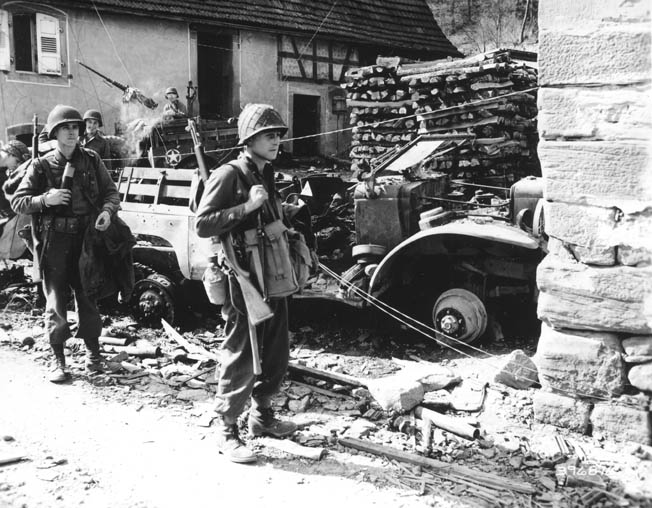
Spark’s Worst Memory of the War
The 157th Regiment would be reconstituted over the following few weeks. It would go on to cross the Siegfried Line and the Rhine River before fighting at Aschaffenburg, Nuremberg, and Munich. Sparks and a company of 3rd Battalion would liberate the Dachau concentration camp. The men taken prisoner at Reipertswiller would go to various POW camps to wait out the war’s end.
Sparks went on to rebuild the postwar Colorado National Guard and would eventually rise to command it.
Johann Voss became a POW himself and, as a member of the SS, looked forward to an uncertain fate. He became a clerk for the U.S. Army before going on to a career as a corporate lawyer.
The Battle of Reipertswiller was a drama of courage, misery, and struggle. Since it was a relatively small battle coinciding with larger events, it received relatively little attention. The men who fought there remember it.
Along with Anzio and Dachau, the battle was Sparks’s worst memory of the war.
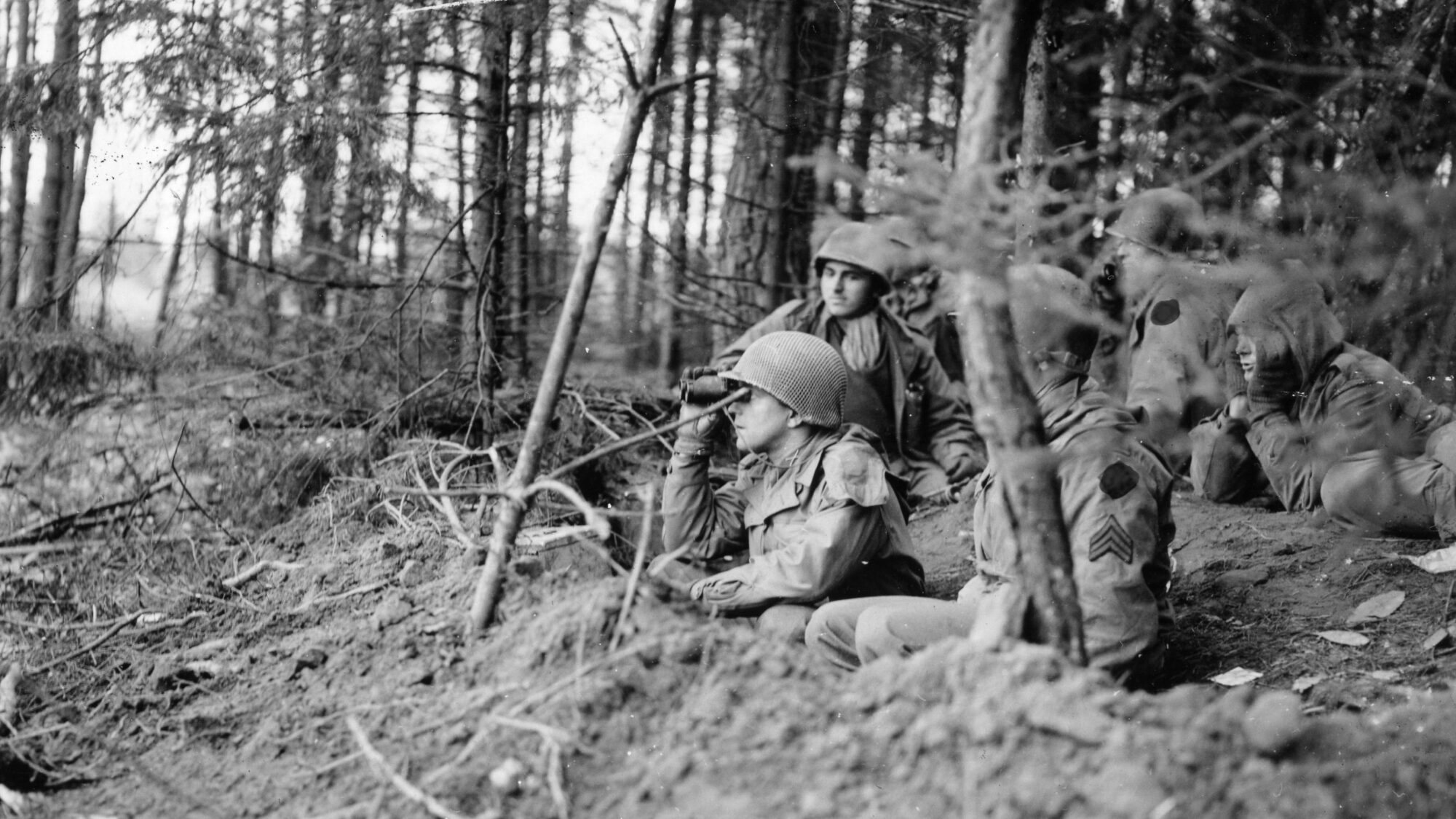
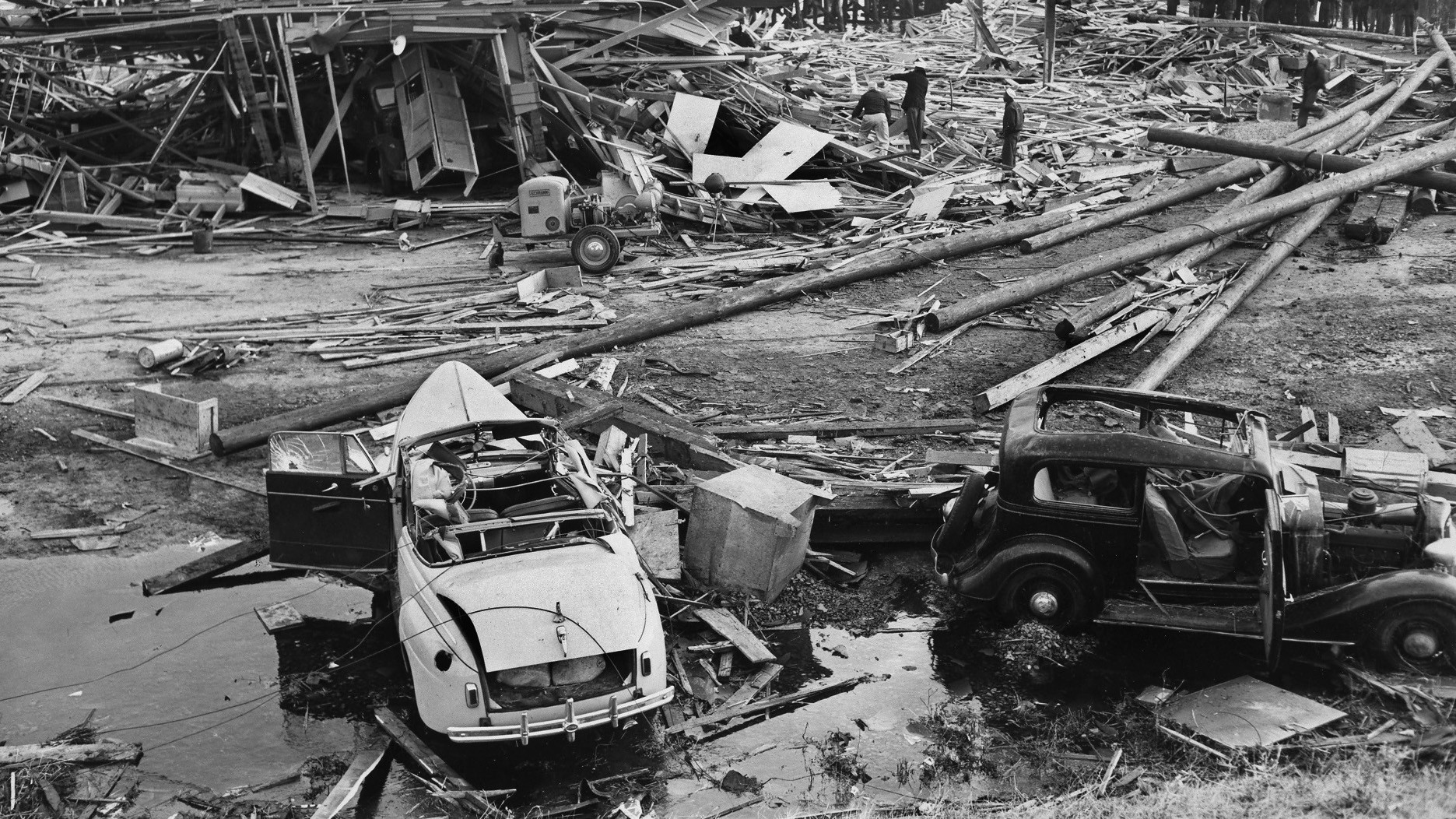

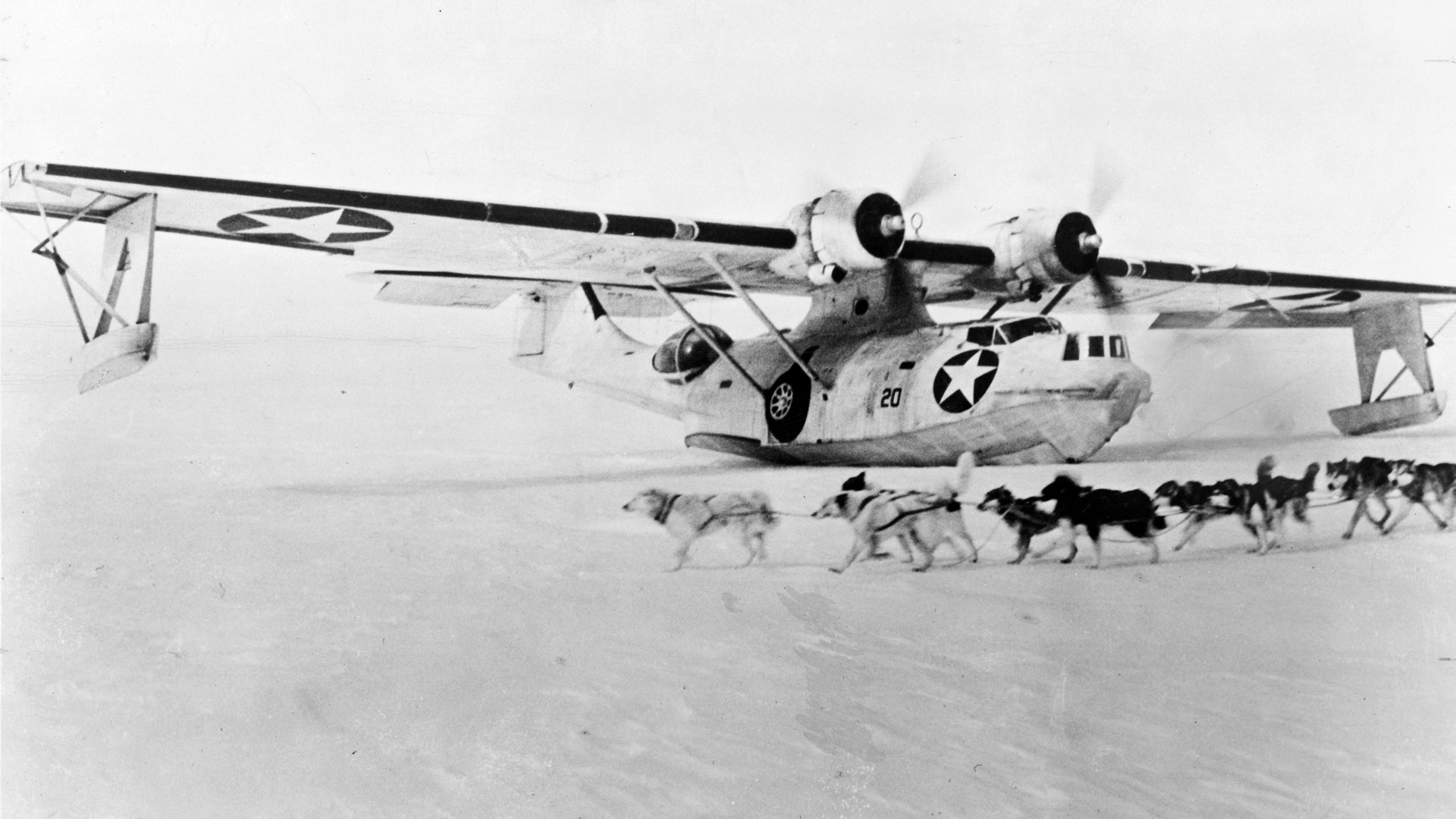
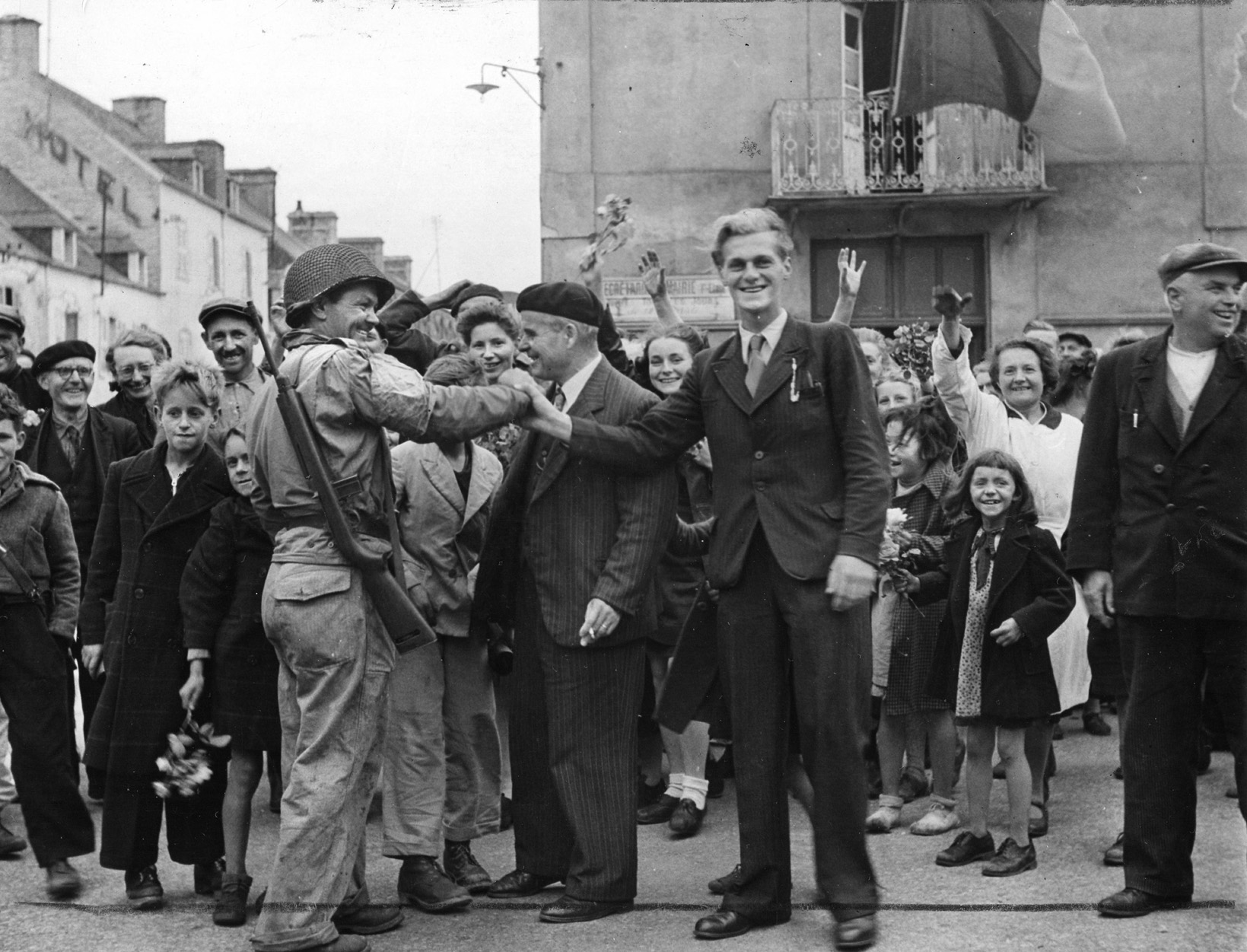
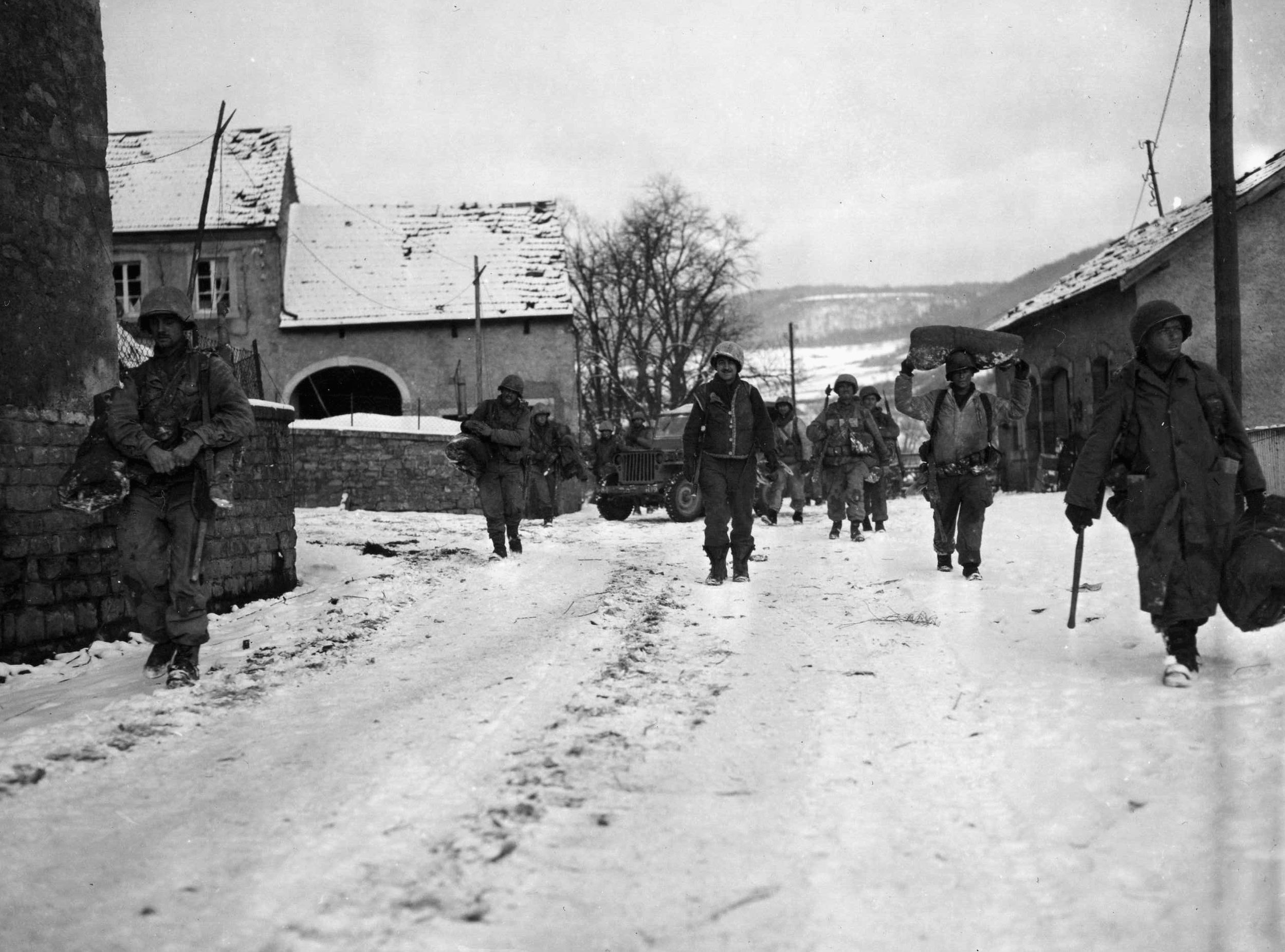
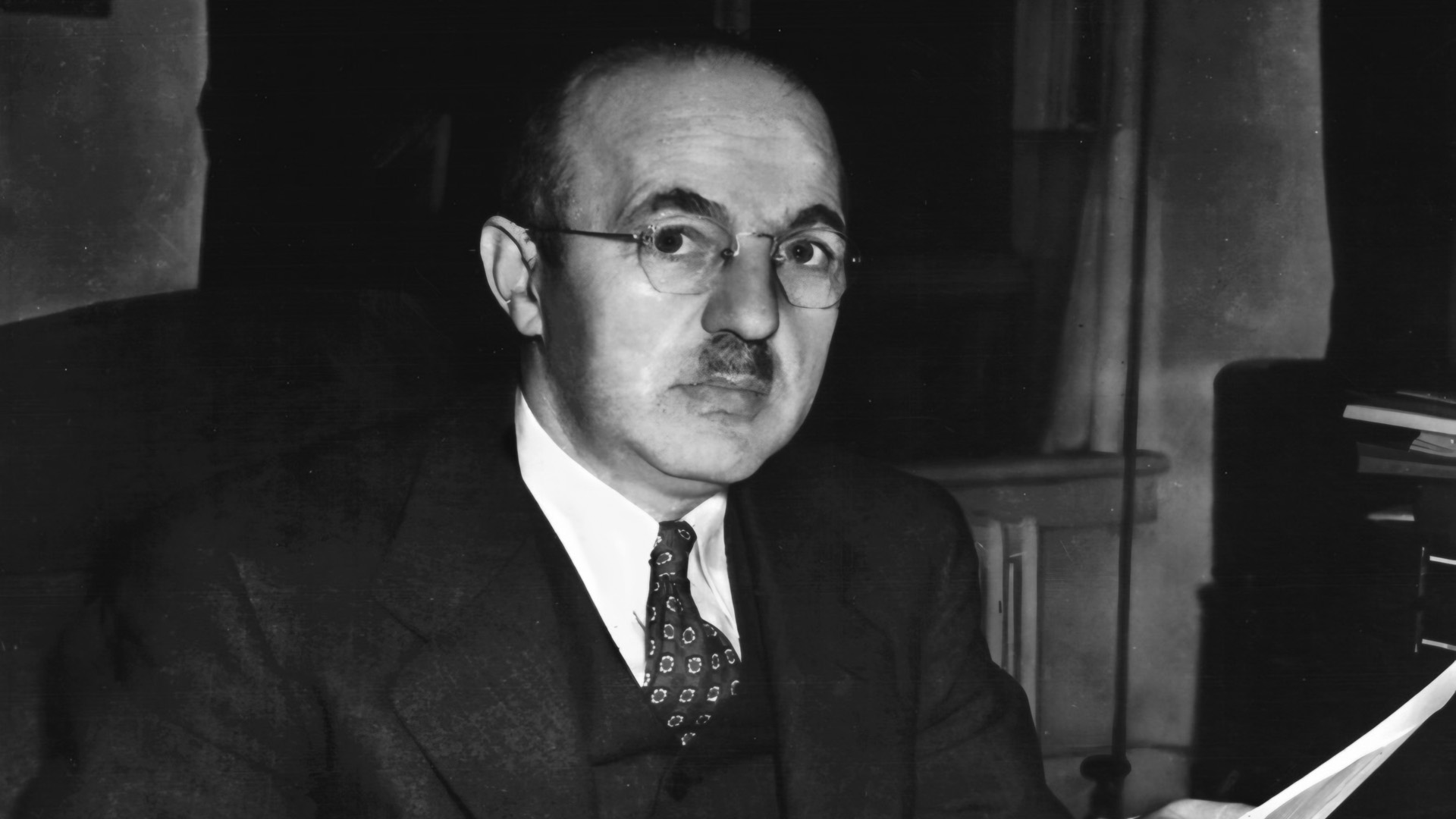
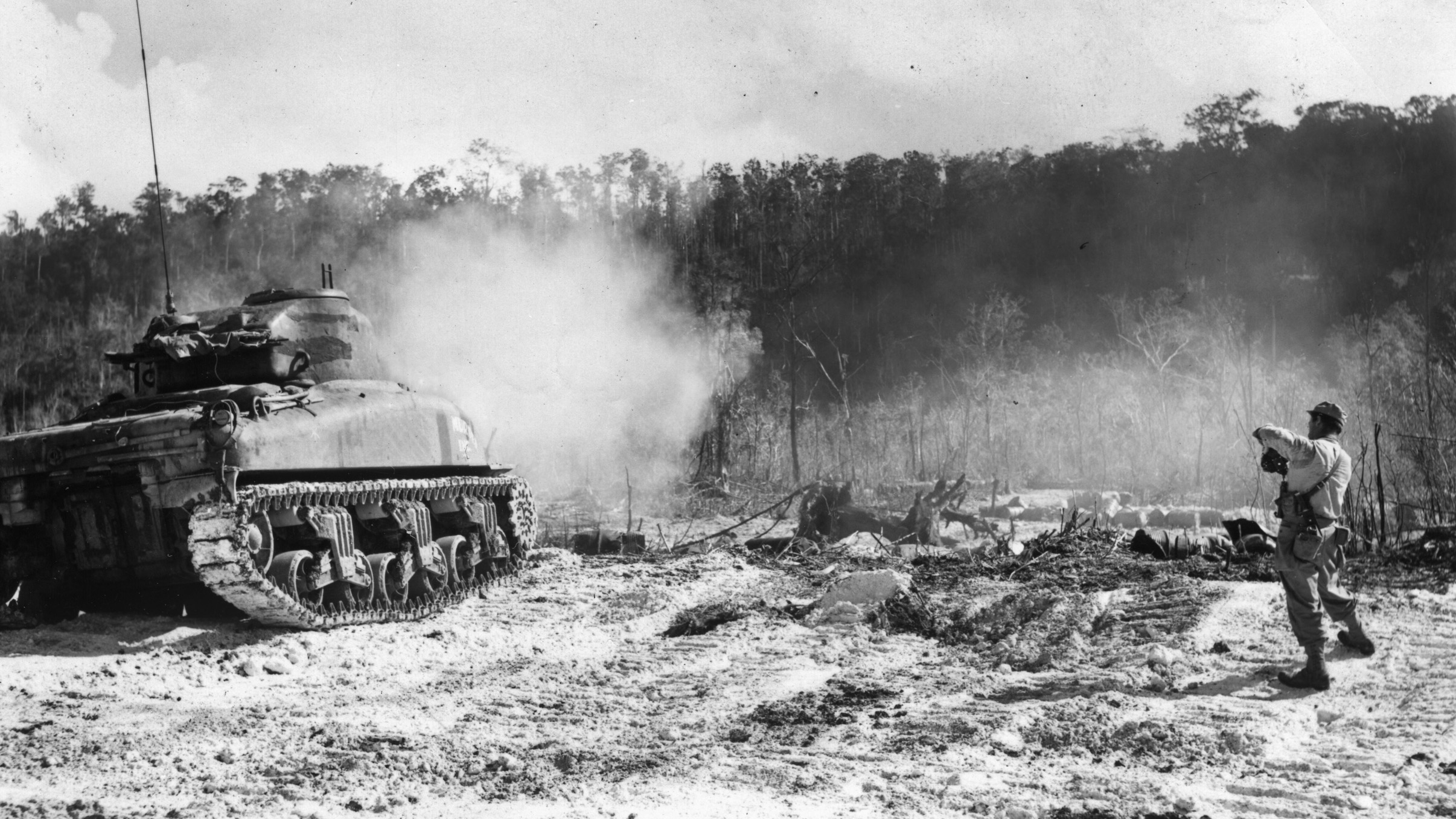
My moms’ older brother PFC Leonard F. Ordway Co. H 157 Infantry 45 Infantry Div. was KIA Jan. 15, 1945 in this engagement.
Would any relative of any member of his outfit maybe have any info about my uncle Len? Thanks, this is such a long shot.
Hello
My father, PFC Michael Lipka was with the 157th during this battle. Kevin, were you able to find any information about your uncle? Possibly in the 45th museum?
Andy Lipka
[email protected]
My daddy was captured on January 21,1945 at the battle of Reipertswille. He was in company E 157th and was wounded. He told me that he was treated by a SS doctor and moved to stalag 12A. My daddy would not talk about the war, somethings yes but few. The Germans issued him a POW paper card with the stalag number and the pow number. He kept that card with him until he passed. This regiment and division were true heros in my book.
Support units such as the 45th Signal Company also suffered casualties and required replacements to be reconstituted as did the combat units.
On January 29, 1945, my late father Felix A. Cizewski was assigned as a replacement to the 45th Signal Company.
You might try to contact a retired Lt. Col. Hugh Foster if he is still with us. He has authored a book on the subject and is/was involved with the 45th Div. veterans group. Several years ago I was researching a relative of a friend who was killed at Reipertswiller and Foster was able to provide amazing details about the when where and how of Private Mahoney’s death.
My late father-in-law Leroy T. Amos was a member of the 3rd/157th. He suffered frost bite but survived this battle. He never forgot the bitter cold or the loss of his comrades. Leroy passed in 2019.
On this Memorial Day, 5/31/2021, I salute my uncle, James Buckley, killed in the Battle of Reipersweiler.
Berdell Buckley
My uncle my dads brother is MIA from 313th 79th infantry div in 1946 His body was not recovered from Reipertswiller France. Does anyone know what exactly happened to him.
My father, Clarence Baker served in 3rd battalion,157th,Military Police Platoon beginning in North Africa and ending in Munich,Germany. He always had good things to say about his Commander,Felix Sparks. Dad passed away in 1994. He maintained contact with some of the men he served with and I had the honor of meeting some of those men. I appreciated the camaraderie being a Vietnam Era veteran. They are all gone now to my knowledge.
my father, lt. raymond shiemke, was in company m of the 3/157. although company m is not mentioned anywhere in this article, my dad described this battle to me including being surrounded, having had most of his men killed, and then, under cover of darkness, sneaking those who were left down the hill through the german line and back to the americans. i know that he led a heavy machine gun platoon at anzio and it may be that his platoon was farmed out to one of the companies mentioned in this article. i know that that happened to him at anzio. and that may explain why company m was apparently not a part of this battle.
but i know that he was there because of the way he described what happened to him there. he made a point of mentioning that once they had made it through what they believed was the last of the germans, they still had to be very careful not to get killed by the americans they were approaching. they made it back thankfully without getting shot by friendly fire. he always said that his reipertswiller experience was among the worst of his memories.
You might try the 45th infantry org for information. They have a facebook page. I was able to find out details of the death of a soldier related to a friend of mine in this way.
So much detail in these articles, I wish there had been mention of the incident Dan, my brother refers to. I’m sure it is included in the mass of information. I’m so glad to see comments of others whose loved ones were involved.
Hello, I am a french student in history and archaeology based in Alsace (France). I give a huge interest for the local history and especially for the WW2 era.
As part of my studies I have chosen to work on a project of mapping the whole area where the 45th DI fought in the low Vosges (also the 70th DI). Then I spent a long time on the battlefields and I’ve been reading many after action reports etc
But something miss me to go further in my analysis, especially for one of the most important stage of the combats in Alsace for the 45th : the encirclement of the 157th at Reipertswiller. Although I think I understood precisely what happened during these few days, the issues, the course of the fighting… but there is something I can’t find anywhere that are testimonies. Sometimes in books I can find a few sentences or extracts from a conversation but I never truly get what was their own experience at an individual scale.
This is was I am writing this comment, wondering if this is somewhere possible to find testimonies from the mens who fought during the Nordwind operation in Alsace, not especially from this particular battle of Reipertswiller even if this is the one on which I am working the most. I saw that many had relatives who fought during this battle, that would invaluable for me to discuss with you, and on the other hand I have a lot to share about the places etc.
Hoping for answers
If you wanna contact me :
[email protected]
Tom
Tom,
This is a long shot, but Alex Kershaw, who wrote a book about Felix Sparks called ‘The Liberator’ and produced an animated film of the same title, was able to interview quite a few survivors of the 45th DI, and a few of the survivors on the German side as well. Have you attempted to contact Mr. Kershaw?
My grandfather was a german soldier KIA in an Infantry attack on Reippertswiller on the 3rd of january 1945 – the attack failed, it was reported that he was hit in the head by a sniper.
After loosing a few men, the company had to retreat and his comrades have not been able to bury the killed german soldiers.
The KIA-Notice which reached my grandmy did not show which Division he was figting in. I can just guess he was in the 257. VGD (Volkdsgrenadierdivision).
His corps was found and recovered in 1981 in a garden next to the street from Baerenthal to REippertswiller. He found his final grave in the war cemetery of Niedrbronn les Bains in 1981.
At this time his body still was an “unknown soldier”, because during the decades in the earth his dogtag which remained on the corps became rusty. He was identified only about 20 years later due to the german “Volkdsgräberfürsorge”, which our family has asked to search for his grave.
He was part of a medical group, his rank was SAN UFFZ (SAN stands for medical)
Anyone who has reports on the german attack to Reippertswiller on the 3rd of january 1945 is welcome to give me more information on it. I’d be glad to hear anything about it.
Email me: [email protected]
My father was First Sgt Don R Renales, 157th infantry Regiment, Company L, 45th Division, 7th Army. I am looking for WW2 info on the experiences of these men. Can anyone direct me to find any information? Thank you.
Hello
There wasn’t any Rocket Launcher other than the WW-2 M-9, M-1 and M-1A1 Caliber 2.36″ – you should correct the caption of the photo with the Bazooka (larger caliber appeared only in Korea)
Doc Snafu
eucmh.com